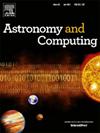宇宙各向异性与芬斯勒-兰德几何和大尺度观测
IF 1.8
4区 物理与天体物理
Q2 ASTRONOMY & ASTROPHYSICS
引用次数: 0
摘要
我们研究了一个建立在Finsler-Randers几何基础上的宇宙学模型,该模型通过Barthel连接引入各向异性修正,并引入与红移相关的η(z)=1+nz形式的参数。该框架扩展了标准宇宙学,纳入了时空的方向依赖性,并修改了主要宇宙学参数的演化,包括哈勃参数H(z)、减速参数q(z)和暗能量状态方程ω(z)。通过将模型拟合到当前的Cosmic Chronometers (CC), Baryon Acoustic oscillation (BAO)和Pantheon+ supernova数据集,我们约束了各向异性参数n,并获得了最新的H0, Ωm0, n和ωDE的最佳拟合值。我们的研究结果表明,线性各向异性可以导致宇宙膨胀的重大变化,预测的哈勃常数H0=68.56±0.10 km/s/Mpc位于普朗克和SH0ES值之间,从而部分缓解了哈勃张力。该研究表明,在芬斯勒-兰德斯框架下的几何各向异性为ΛCDM提供了物理动机的扩展,并为在芬斯勒几何背景下研究现代宇宙学中的突出挑战提供了新的可能性。本文章由计算机程序翻译,如有差异,请以英文原文为准。
Cosmological anisotropies with Finsler–Randers geometry and large-scale observations
We investigate a cosmological model grounded in Finsler–Randers geometry introducing anisotropic corrections via the Barthel connection and a redshift-dependent parameter of the form . This framework extends standard cosmology by incorporating directional dependencies in spacetime and modifies the evolution of principal cosmological parameters including the Hubble parameter , deceleration parameter and dark energy equation of state . By fitting the model to current Cosmic Chronometers (CC), Baryon Acoustic Oscillations (BAO), and Pantheon+ supernova datasets, we constrain the anisotropy parameter and obtain updated best-fit values for , , and . Our results indicate that the linear anisotropy can lead to non-trivial modifications in cosmic expansion with the predicted Hubble constant km/s/Mpc lying between the Planck and SH0ES values, thereby partially alleviating the Hubble tension. This study demonstrates that geometric anisotropy within the Finsler–Randers framework provides a physically motivated extension to CDM and offers new possibilities of studying outstanding challenges in modern cosmology in Finsler geometric background.
求助全文
通过发布文献求助,成功后即可免费获取论文全文。
去求助
来源期刊

Astronomy and Computing
ASTRONOMY & ASTROPHYSICSCOMPUTER SCIENCE,-COMPUTER SCIENCE, INTERDISCIPLINARY APPLICATIONS
CiteScore
4.10
自引率
8.00%
发文量
67
期刊介绍:
Astronomy and Computing is a peer-reviewed journal that focuses on the broad area between astronomy, computer science and information technology. The journal aims to publish the work of scientists and (software) engineers in all aspects of astronomical computing, including the collection, analysis, reduction, visualisation, preservation and dissemination of data, and the development of astronomical software and simulations. The journal covers applications for academic computer science techniques to astronomy, as well as novel applications of information technologies within astronomy.
 求助内容:
求助内容: 应助结果提醒方式:
应助结果提醒方式:


